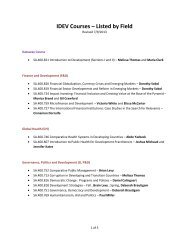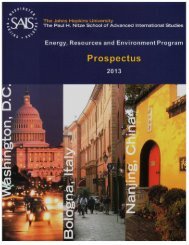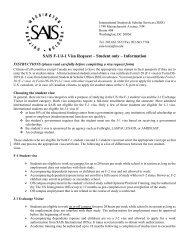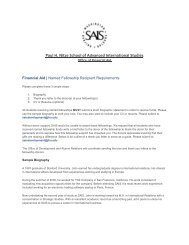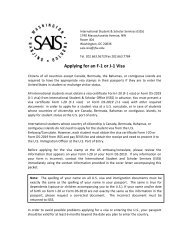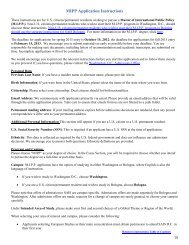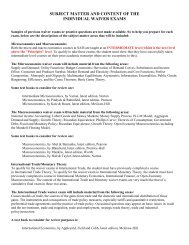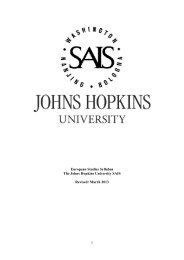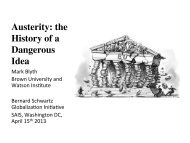- Page 1:
Johns Hopkins University School for
- Page 7 and 8:
Acknowledgements We are most gratef
- Page 9 and 10:
List of Acronyms AKP Adalet ve Kalk
- Page 12 and 13:
xii
- Page 14 and 15:
proposed goal (as in the previous e
- Page 16 and 17:
democracy is a continual testing pr
- Page 19 and 20:
What’s in a Revolution? The timin
- Page 21 and 22:
limited to Tunisia, these vivid dep
- Page 23 and 24:
political system before any of the
- Page 25:
discontent of so many in Tunisia wh
- Page 28 and 29:
eality,” signified by Tunisian pe
- Page 30 and 31:
mantra sparked the Kasbah sit-ins r
- Page 32 and 33:
in early January of 2011, you would
- Page 34 and 35:
independence from the Ottoman Empir
- Page 36 and 37:
ack to the 1970s (SAIS Group Meetin
- Page 39 and 40:
Two Tunisias: How A Revolution Whic
- Page 41 and 42:
continued to cite statistics claimi
- Page 43 and 44:
inequality were most severe. Combat
- Page 45 and 46:
in government could drop precipitou
- Page 47:
for bold political leadership in Tu
- Page 50 and 51:
History of Secularism in Tunisia In
- Page 52 and 53:
1) Freedom to form and to join orga
- Page 54 and 55:
Source: Stepan, Alfred C. “Religi
- Page 56 and 57:
terms of campaigning, the political
- Page 58 and 59:
that in practice many people who es
- Page 60 and 61:
Short-term • Secular parties must
- Page 63 and 64:
Islamism and Laïcité in the Tunis
- Page 65 and 66:
girl, a high-achieving student at h
- Page 67 and 68:
laws are either supported directly
- Page 69 and 70:
and she argues that he, like many s
- Page 71 and 72:
during exams, preventing other stud
- Page 73 and 74:
Constituent Assembly should keep th
- Page 75 and 76:
Women’s Rights in Tunisia: A “N
- Page 77 and 78:
dismiss the question as a non-issue
- Page 79 and 80:
In immediate post-revolutionary Tun
- Page 81 and 82:
Others express concern about the va
- Page 83 and 84:
something every Tunisian boy does n
- Page 85 and 86:
Mr. Ghannouchi is equally surprised
- Page 87 and 88:
Mr. Hedri showed concern over the l
- Page 89:
has occurred in response to politic
- Page 93 and 94:
The Post-Transition Constitutional
- Page 95 and 96:
Theoretical Literature While there
- Page 97 and 98:
Tunisian Case Following Ben Ali’s
- Page 99 and 100:
parties. With the internal arrangem
- Page 101 and 102:
issues of unemployment, reduced cor
- Page 103 and 104:
Recommendations • NCA and politic
- Page 105 and 106:
Political Party Development Amy Ham
- Page 107 and 108:
experience and expertise, will be k
- Page 109 and 110:
with Laryssa Chomiak, SAIS group me
- Page 111 and 112:
epresented a complete departure fro
- Page 113 and 114:
To some extent, the focus on the qu
- Page 115 and 116:
• Enhance the legitimacy and enfo
- Page 117 and 118:
Ennahdha and the Salafis Roberta Lu
- Page 119 and 120:
The trial against Nabil Karoui, the
- Page 121 and 122:
Some Possible Explanations The hesi
- Page 123 and 124:
the salafist movement Al-Salafiya A
- Page 125 and 126:
violence, to lay the bases for a ne
- Page 127 and 128:
Tunisian Civil Society Before and A
- Page 129 and 130:
Bourguiba,” Bellin points out,
- Page 131 and 132:
nip in the bud any challenges to pa
- Page 133 and 134:
“training-of-trainers” (ToT) ev
- Page 135 and 136:
The focus of civil society groups i
- Page 137 and 138:
economic development in Tunisia. Th
- Page 139 and 140:
The Tunisian Youth Fallout: A Look
- Page 141 and 142:
that they found voting to be the mo
- Page 143 and 144:
head (Dégage, 2011). It should the
- Page 145 and 146:
graduates are unemployed (SAIS Grou
- Page 147 and 148:
to participate as a citizen in a de
- Page 149 and 150:
are rumored to consist only of 3,00
- Page 151 and 152: Medium-term • At some point, the
- Page 153 and 154: Part III: Security, Justice and Eco
- Page 155 and 156: The Role of the Military in Post-Be
- Page 157 and 158: insufficient to prevent the demonst
- Page 159 and 160: disruptions during voting, the tota
- Page 161 and 162: This is in sharp contrast to the mi
- Page 163 and 164: Recommendations While the military
- Page 165 and 166: Internal Security and Reform in Tun
- Page 167 and 168: The Implements of Repression There
- Page 169 and 170: undesirable organizations, stifle d
- Page 171 and 172: evolution, many police, especially
- Page 173 and 174: A Way Forward: Policy Reforms At pr
- Page 175 and 176: Transitional Justice and National R
- Page 177 and 178: Those released therefore included p
- Page 179 and 180: The current situation in many ways
- Page 181 and 182: circulating that the informal strik
- Page 183 and 184: the commercial interests of the ban
- Page 185 and 186: and clear limits to police behavior
- Page 187 and 188: Addressing Unemployment Rebekah Cha
- Page 189 and 190: The forecasting is based on the ass
- Page 191 and 192: of its revolution. This has had a c
- Page 193 and 194: Boosting the Tourism Sector The tou
- Page 195 and 196: absorb all of the university gradua
- Page 197 and 198: language and technology skills, whi
- Page 199 and 200: Understanding Unemployment in Tunis
- Page 201: ather than shifts from low to high
- Page 205 and 206: the Tunisian economy. Thus, creatin
- Page 207 and 208: • Encourage entrepreneurship: Tra
- Page 209 and 210: U.S. Assistance in Tunisia Cody Die
- Page 211 and 212: cultural differences that may inhib
- Page 213 and 214: the Constitutional Assembly in Tuni
- Page 215 and 216: order to receive these funds over o
- Page 217 and 218: and access to jobs in Libya for Tun
- Page 219 and 220: Conclusion P. Terrence Hopmann The
- Page 221 and 222: the domination of the salafis and o
- Page 223 and 224: well educated, but under or unemplo
- Page 225 and 226: persons, a huge contingent for such
- Page 227 and 228: List of Interviewees Washington DC,
- Page 229 and 230: • Salah Bourjini, former division
- Page 231 and 232: • Ahmed Ibrahim, Secretary of the
- Page 233 and 234: Bibliography Abouzeid, Rania. 21 Ja
- Page 235 and 236: Cook, Steven A. 20 January 2011.
- Page 237 and 238: Le Monde. 25 January 2011. “Tunis
- Page 239 and 240: Silver, Vernon. 12 December 2011.
- Page 241: World Bank. 2004. “Dynamique de L



